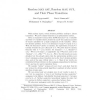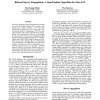6 search results - page 1 / 2 » Random MAX SAT, random MAX CUT, and their phase transitions |
SODA
2003
ACM
13 years 5 months ago
2003
ACM
With random inputs, certain decision problems undergo a “phase transition”. We prove similar behavior in an optimization context. Given a conjunctive normal form (CNF) formula...
CPC
2006
13 years 4 months ago
2006
Abstract. We show that a maximum cut of a random graph below the giantcomponent threshold can be found in linear space and linear expected time by a simple algorithm. In fact, the ...
AAAI
2008
13 years 6 months ago
2008
The survey propagation (SP) algorithm has been shown to work well on large instances of the random 3-SAT problem near its phase transition. It was shown that SP estimates marginal...
JAIR
2007
13 years 4 months ago
2007
Exact Max-SAT solvers, compared with SAT solvers, apply little inference at each node of the proof tree. Commonly used SAT inference rules like unit propagation produce a simpli�...
FOCS
1995
IEEE
13 years 8 months ago
1995
IEEE
This paper continues the investigation of the connection between probabilistically checkable proofs
PCPs
the approximability of NP-optimization problems. The emphasis is on prov...


